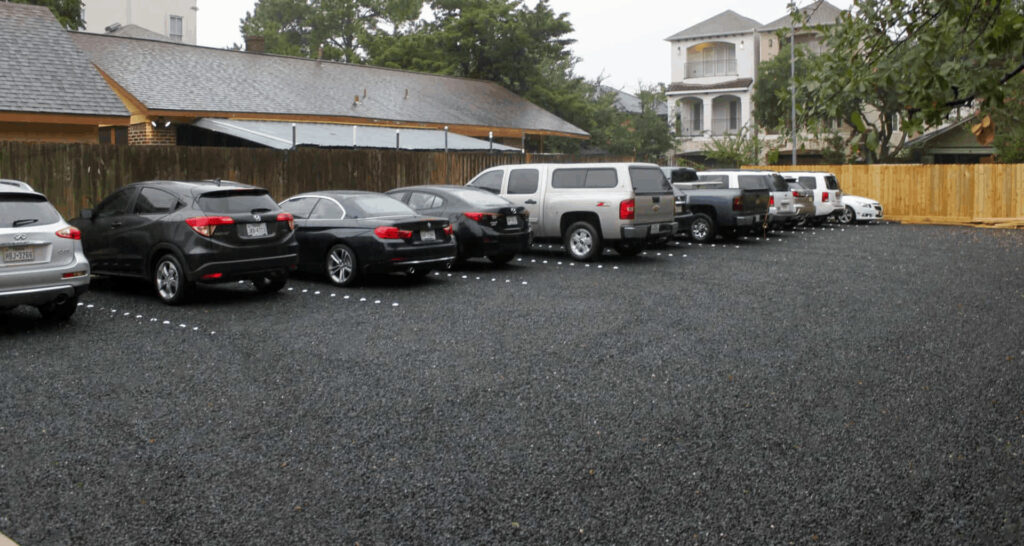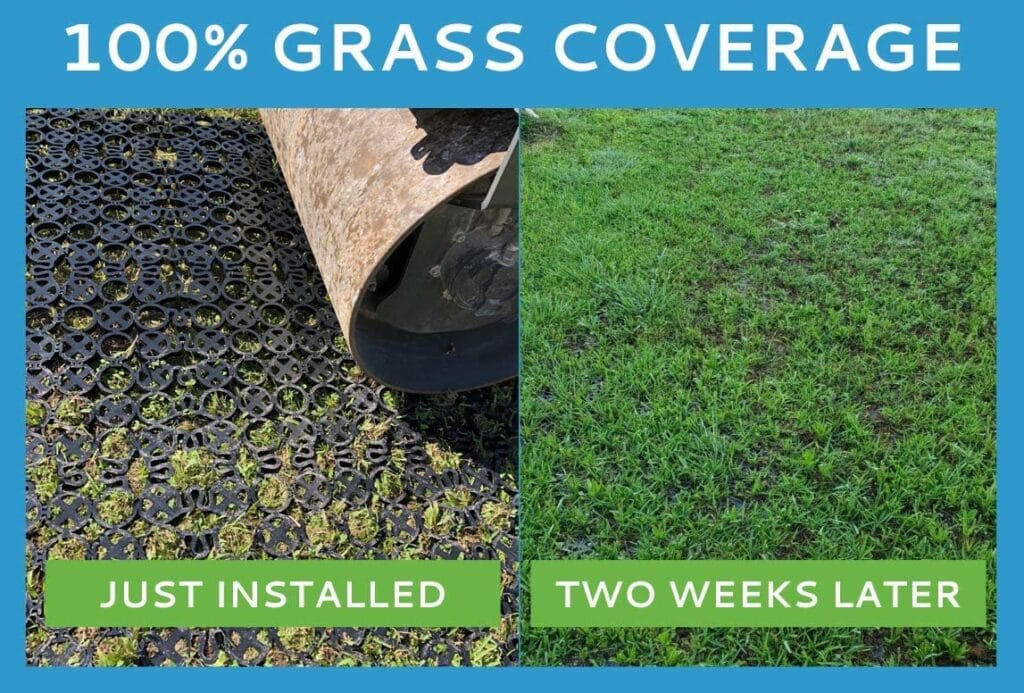In the world of property management and development, understanding parking ratios and how to calculate them is fundamental. Whether it’s for a commercial building or a residential area, parking ratios can significantly influence both design and capacity.

This guide will delve into how to calculate parking ratios, discuss parking lot design and maintenance, and introduce TRUEGRID® permeable pavers, an innovative, eco-friendly solution for modern parking lots.
Understanding Parking Ratios
Parking ratios are an important framework for designating the number of parking spaces required per unit or per square footage in a given area. They provide a standard measure that allows for uniformity and consistency across various types of establishments, whether residential, commercial, or public facilities.
How to Calculate Parking Ratios
To calculate a parking ratio, you will need to divide the total number of parking spaces by the square footage of the building. For instance, if you have a commercial building with 20 parking spaces and a total of 10,000 square feet, the parking ratio would be calculated as follows:
Number of Parking Spaces / Total Square Feet = Parking Ratio
In this case, the calculation would yield a parking ratio of 2 spaces per 1,000 square feet. Most commercial parking spaces (or bays) are about 200 square feet, on average, in North America.
This standard measure helps to ensure that sufficient parking is available for the estimated usage of the facility.
The Role of Parking Lot Design
In designing parking lots, consideration must be given not only to capacity but also to maintenance and environmental impact. Traditional parking lot materials, such as concrete and asphalt pose certain challenges. They require regular upkeep, are prone to cracking and damage, and create runoff issues due to their non-permeable nature.
The Drawbacks of Traditional Parking Lot Materials
Concrete and asphalt have long been the materials of choice for constructing parking lots. While they serve the purpose of providing a hard surface for vehicles, there are notable challenges associated with these traditional materials:
1. Maintenance and Durability
Due to their inherent characteristics, concrete and asphalt gradually degrade over time. This leads to the formation of cracks and potholes, a problem amplified in regions subject to cyclical freezing and thawing conditions. This deterioration compromises not only the aesthetic integrity of the parking lot, but also poses potential safety risks to both vehicular and pedestrian traffic.
2. Impermeability and Runoff
Concrete and asphalt are both impermeable, meaning they do not allow water to seep through their surface. When it rains, water can’t infiltrate the surfaces, and instead becomes runoff. This can lead to several problems:
- Stormwater Management Issues: Increased runoff can strain municipal stormwater systems, which can lead to overflow and potential flooding.
- Pollution: Runoff can pick up contaminants like oil and chemicals from the parking surface, and carry the pollutants into local waterways.
- Heat Island Effect: Concrete and asphalt absorb heat, which causes urban areas to become significantly warmer than surrounding rural areas. This phenomenon is known as the urban heat island effect.
3. Lack of Aesthetic Appeal
Concrete and asphalt parking lots, due to their monotone gray or black surfaces, often lack aesthetic appeal. It may not be a concern for purely functional spaces, but for residential complexes, businesses, and public spaces looking to maintain a visually pleasing environment, it can be a disadvantage.
4. Periodic Repainting and Re-Striping
The painted lines for parking bays on concrete and asphalt need to be re-done at least every 5 years. However, in harsh weather areas, re-striping is recommended every 12 to 24 months. This means restricting access to the parking lot for hours or days for the scheduled maintenance.
By considering these types of challenges, it becomes clear that alternative solutions like TRUEGRID® permeable pavers are a more durable, eco-friendly, and visually appealing solution for parking lot construction.
The TRUEGRID® Solution

TRUEGRID® permeable pavers are a revolutionary approach to parking lot construction and design. Here are some of the key advantages of TRUEGRID® permeable pavers:
- Durability and Low Maintenance: Unlike traditional materials, TRUEGRID® pavers are highly durable and require minimal maintenance, which makes them a cost-effective choice in the long run.
- Environmentally-Friendly: TRUEGRID® pavers are permeable, which means they allow water to pass through, which reduces issues related to stormwater runoff. This design contributes positively to flood control and groundwater recharge.
- Aesthetic Versatility: Parking lots don’t have to be drab expanses of concrete or asphalt. They can be filled with a variety of materials, with the TRUEGRID® pavers, even grass, to create a visually pleasing and eco-friendly solution.
Embracing Eco-friendly Solutions with TRUEGRID®
As we move toward more sustainable practices in various fields, the construction industry has not been left behind. Integrating eco-friendly solutions like TRUEGRID® permeable pavers, especially when combined with grass, can significantly contribute to an environmentally-conscious approach in parking lot construction.
1. Enhanced Stormwater Management

Existing grass stabilizing TRUEGRID® ROOT® Pavers facilitate natural water infiltration. Unlike concrete and asphalt that lead to runoff, these pavers allow water to permeate through the grass and into the ground. TRUEGRID® permeable pavers support efficient stormwater management by reducing the burden on municipal drainage systems and decreasing the risk of flooding.
2. Support for Local Ecosystems
Grass infill and gravel infill in permeable parking lots is more than just an aesthetic feature; it also plays an essential role in supporting the local ecosystem. Grass and soil serve as natural filters, by trapping pollutants and preventing them from entering waterways. In addition, grassy areas can provide habitat for beneficial insects to help contribute to local biodiversity.
3. Natural Cooling and Carbon Sequestration
Unlike asphalt or concrete, grass does not absorb heat. Instead, it helps cool the surroundings, to help mitigate the urban heat island effect commonly caused by traditional parking lots. Grass also absorbs carbon dioxide from the atmosphere in order to help offset greenhouse gas emissions—a process known as carbon sequestration.
4. Aesthetic Appeal and User Experience
Beyond their ecological benefits, gravel-filled or grass-filled TRUEGRID PRO PLUS ® permeable pavers significantly enhance the aesthetic appeal of parking lots. The integration of green spaces into otherwise gray and lifeless areas can dramatically improve the look and feel of the environment, in order to provide a positive experience.
By utilizing TRUEGRID® permeable pavers filled with gravel or grass, developers and property managers can create functional, beautiful, and environmentally-responsible parking solutions, which demonstrates a commitment to sustainability without compromising on the essential requirements of parking lot design.

5. SuperSpot® and SnowSpot Delineators
TRUEGRID® has PRO PLUS® insets called SuperSpot®s and SnowSpots for easy parking delineation. Simply place the “spot” in an empty grid cell in place of painted stripes. TRUEGRID®’s delineators will last the life of the parking lot with no need for replacement or maintenance. SuperSpot®s are raised above the grid for use in warm climates or for high-visibility. SnowSpots, when installed, are flush level with the top of the PRO PLUS® and can be used in cold climates where snow plowing is common. Any number of custom markings or numbering can be accomplished with the spots.
Meet Your Parking Ratio Requirements with TRUEGRID® Solutions
TRUEGRID® is a leading provider of permeable pavers that offer durable, low-maintenance, and eco-friendly solutions for parking lot construction. Our innovative pavers enable developers and property managers to meet their parking ratio requirements while enjoying the benefits of a green parking lot, and an aesthetically pleasing environment.
For more information on how TRUEGRID® can help you create an eco-friendly parking lot, contact us today!



